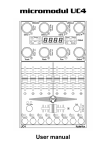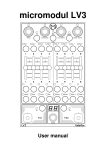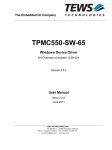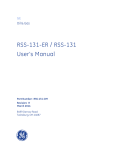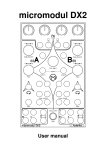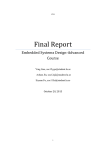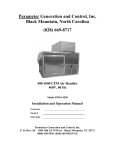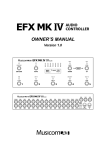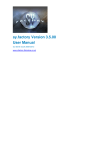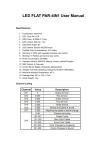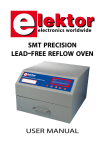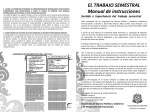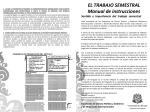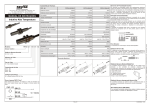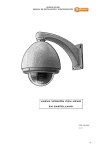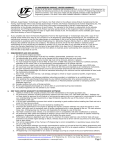Download Manual - Faderfox
Transcript
micromodul SC4 User manual Provision of guarantee and product liability The seller warrants for faultless material and proper manufacture for a period of 24 months from the date of sale to the end user. Excluded from the stated guarantee are defects on parts as the result of normal wear-and-tear. These parts are mostly faders (sliding guides), potentiometers, encoders, buttons, switches and touchpads. Also excluded from the guarantee are damages that are the result of : incorrect or inappropriate handling, excessive force, mechanical or chemical influences, incorrectly connecting the instrument with other instruments, incorrect or inappropriate use. The warranty is void if the instrument is opened or changed. In addition, there is no warranty for individual parts and components (in particular, semiconductors) and disposables/ consumables. The seller is not liable for consequential damages which are not the result of criminal intent or negligence on his part. The following conditions must be met in order to claim the warranty services: - Instrument is either in its original packaging or similar packaging. - Copy of the invoice with the serial number clearly visible. - Meaningful error report or description of the error is attached. The buyer assumes all costs and dangers of return shipments to the manufacturer. Since the user’s manual which is included with each instrument also affects the warranty conditions (especially regarding safety issues), it is absolutely essential that you read through and follow all instructions. Safety precautions and servicing - Instrument's intended use is based on the functions and procedures contained in this manual - Read all instructions for use as well as all enclosed literature before using the instrument - Use only in closed rooms (not for outdoor use) - Never use in a moist or humid environment (laundry rooms, swimming pools, etc, …) - Not for use in the vicinity of heat sources (radiators, ovens, etc, …) - Operational temperature is in the range of 0‚ - + 40‚ C - Not for use in the vicinity of flammable material - The instrument should not be in direct or prolonged contact with sunlight - Dusty environmental conditions should be avoided - Connect only to USB ports of computers or hubs - No foreign objects are permitted inside the instrument casing - No liquids should get inside the instrument casing - Never let the instrument fall to the ground (casing and/or control elements may be damaged) If the instrument must be opened (for example, to remove foreign objects from the casing or for other repairs), this may only be done by qualified personnel. The USB-cable must be disconnected before opening the instrument. Guarantee is void for defects that occur if the instrument was opened by an unauthorised or unqualified person. Use a soft towel or brush to clean the instrument. Please do not use any cleaning liquids or water, so you avoid any damages to the instrument. Package contents - Device - USB cable (with angle plug) - Midi adapter cable (with angled 3.5mm jack plug) - Manual / Quick start guide - CD with settings and manuals Introduction Thank you for choosing a Faderfox controller. These probably world’s smallest controllers are designed for live use on stage. All Faderfox controllers are professionally hand crafted in Germany ensuring high quality. The 4th generation brings a lot of new features like additional MIDI connections, black faceplates with laser engraving and updatable firmware. First part of the SC4 is a universal controller for all kinds of midi controllable hard- and software. The all-rounder has 8 push-encoders with detents, all switchable to 8 controller groups that allow to control a total amount of 128 control parameters. Amazing LED crowns show the current values of all encoders and push buttons in a very ergonomic way. Various kinds of midi commands like program change, pitchbend and control change in relative and absolute mode with different acceleration amounts are possible. All these properties are fully programmable on the devices very fast and easy for each control separately. A small display informs about programmings and control values. The encoders can work as high resolution 14bit controllers too (control change or pitchbend) which makes them suitable for sensitive parameters like resonating filter cutoffs or similar things. Use the internal 30 setups to save your individual settings. Backup and restore of all settings by sysex dumps is possible too. The factory settings are perfect to control music and video software products out of the box if they are freely assignable. So any additional device programming isn’t necessary for many applications. The little box is also a great extension for your Ableton Live setup. There you can control all the continues parameters like track volumes, rack macros, send amounts, track pannings etc. A special control surface script for Ableton Live 8/9 with all necessary mappings is enclosed in the package. With that script you can also use two SC4 devices to control up to 16 tracks simultaneously. The integrated monophonic sequencer with 8 tracks and 8 patterns is another highlight of the SC4. The sequence unit is a bit similar to the M185 seuencer from RYK with a lot of extensions. First you can switch each of the 8 controller groups to any of 7 different track types like note, octave, repeat, CC, accent/link, length/skip and probability. Each of the 8 available sequencer stages of a pattern can have its own length about 1 to 8 clocks which was also one of the unique features of the M185 sequencer. Two special groups controls various pattern and sequencer functions. 8 patterns with 8 stages are linkable to a maximum amount of 64 stages. You can write, reload and copy patterns on the fly. Because of many different sequencer functions like tempo, gate length, transpose, swing, scale and direction the SC4 becomes very flexible. Of course there are also midi clock sync, tempo tap, clock reset, reset counter and a nudge functions to get the perfect sync with your other gear. Remote the sequencer transpose, direction, clock reset and pattern select by a connected midi keyboard to have a much greater performance. Special random and probability functions give your tracks more variations and liveness. Combinations of controller and sequencer groups are possible as well and all of these you can program independently for each of the 30 setups. Simultaneous control of external gear and software instruments is no problem for the SC4 due to the available USB and MIDI ports. Check out this amazing power box and you will get a reliable mate... Features - Universal controller and sequencer for all kinds of midi controllable hard- and software - iPad compatible with camera connection kit - Control surface script for Live 8/9 is shipped with the controller (no manual mapping necessary) - USB interface with bus powering - class compliant / no driver necessary (consumption < 500mW) - MIDI in and out ports with routing and merge functionality - 8 push encoders with detents (resolution about 30 pulses) - 8 LED crowns to show current values of all encoders and push buttons - 4-digit-display to show control values and programming data - 14 bit high resolution encoder mode for sensitive parameters - Data feedback for encoders avoid value jumps - All controls (incl. push buttons) fully programmable in the device by channel, type, number and mode - Different command types like control change (CC), pitch bend, program change and notes - Advanced programming functions like copy, paste and channel set - 8 groups for all controls - About 128 commands per setup (16 controls x 8 groups) - Integrated sequencer with 8 configurable tracks (7 different track types like note, repeat, CC, length/skip, accent/link etc.) - 8 sequencer patterns with each 8 stages are linkable to max. 64 stages - Remote function by a connected midi keyboard (transpose, direction, pattern select) - 30 setups with backup/restore function contain controller and sequencer settings for groups and patterns - Very compact design in a black casing with metal faceplate (laser engraving, 180x105x70 mm, 350 g) System requirements - PC or Mac with a free USB port (1.0 or higher) or any USB hub (connection by inclosed USB cable) - iPad with iOS5 or higher (connection by apples camera connection kit) - MIDI device with standard midi in port (5pin DIN socket connection by enclosed adapter cable) - USB power adapter (5V min 200mA) if you want to control only midi gear Controller mode Controller mode is the basic mode of the SC4. Here the encoders are used to control any parameters in your soft- or/and hardware by standard midi commands like CC and notes. First choose the group by the green buttons. The display shows the group name: GrP1....GrP8 Turning and pushing of the encoders can send different commands which you can program in edit mode. LED crowns and red LED’s in the center of the crowns show the current value and states of the corresponding encoders. After turning or pushing any encoder you can see the numerical value in the display too. A programmed acceleration gives a better feeling for the encoders so you can go from min to max value easily. Hold any shift key while you turn the encoders to have a precise control without acceleration. To get the encoder value shown on the display without changing, hold any shift key and press the encoder. The right point in lower right corner of the display shows incoming midi data. It flashes bright when the device receives controller data. Low flashing indicates midi clock or other midi data. Ableton Live mode The setups 28 to 30 are preconfigured for using with Live 8/9. The display shows special group names (see below). Setup 28 is recommended to control parameters of selected track (tracks below track 16 are available too): GrP1....GrP4 For free use trAC (group 5) controls various parameters of the selected track - encoder 1: track send 1(A), push button 1: track view - encoder 2: track send 2(B), push button 2: clip view - encoder 3: track send 3(C), push button 3: stop clip (red led shows stopped clip) - encoder 4: scene select, push button 4: launch clip (red led shows available clip) - encoder 5: track select, push button 5: track arm (red led shows arm state) - encoder 6: crossfader assign, push button 6: track monitor (red led shows state) - encoder 7: track pan, push button 7: track solo (red led shows solo state) - encoder 8: track volume, push button 8: track active (red led shows active state) Vol (group 6) Volume and track active of track 1 to 8 RAC (group 7) Rack control of macros 1 to 8 and some rack functions - encoder 1: macro 1, push button 1: track view - encoder 2: macro 2, push button 2: rack on/off - encoder 3: macro 3, push button 3: previous rack - encoder 4: macro 4, push button 4: next rack - encoder 5: macro 5, push button 5: show rack - encoder 6: macro 6, push button 6: lock rack - encoder 7: macro 7, push button 7: previous track - encoder 8: macro 8, push button 8: next track GLob (group 8) Global controls - encoder 1: tempo coarse, push button 1: nudge down - encoder 2: tempo fine, push button 2: nudge up - encoder 3: quantization, push button 3: stop scene - encoder 4: scene select, push button 4: launch scene - encoder 5: track select, push button 5: start - encoder 6: cue volume, push button 6: stop - encoder 7: master pan, push button 7: record - encoder 8: master volume, push button 8: view arrangement/session Setup 29 and 30 are recommended to control parameters of 8 tracks simultaneously (setup 29 = tracks 1 to 8, setup 30 = tracks 9 to 16): Snd1 (group 1) controls parameter send 1(A) for 8 tracks Snd2 (group 2) controls parameter send 2(B) for 8 tracks Snd3 (group 3) controls parameter send 3(C) for 8 tracks Snd4 (group 4) controls parameter send 4(D) for 8 tracks Pan (group 5) controls panorama for 8 tracks Vol (group 6) Volume and track active for 8 tracks RAC (group 7) Rack control of macros 1 to 8 and some rack functions - encoder 1: macro 1, push button 1: track view - encoder 2: macro 2, push button 2: rack on/off - encoder 3: macro 3, push button 3: previous rack - encoder 4: macro 4, push button 4: next rack - encoder 5: macro 5, push button 5: show rack - encoder 6: macro 6, push button 6: lock rack - encoder 7: macro 7, push button 7: previous track - encoder 8: macro 8, push button 8: next track GLob (group 8) Global controls - encoder 1: tempo coarse, push button 1: nudge down - encoder 2: tempo fine, push button 2: nudge up - encoder 3: quantization, push button 3: stop scene - encoder 4: scene select, push button 4: launch scene - encoder 5: track select, push button 5: start - encoder 6: cue volume, push button 6: stop - encoder 7: master pan, push button 7: record - encoder 8: master volume, push button 8: view arrangement/session Sequence mode In sequence mode the encoders are used to control different stage parameters depending of the track type. First choose the track by the green buttons. The display shows the track name/type (see below). Turning and pushing the encoders changes track parameter in the 8 stages of a pattern. LED crowns and red LEDs in the center of the crowns show the current value and stages’ states. After turning or pushing any encoder you can see the numerical value in the display too. Hold left shift key while you turn the encoders to change all 8 stages at once. If you hold right shift key and press any push encoder, all 8 stages will change to same states. To get the encoder value shown on the display without changing, hold left shift key and press the encoder. Blinking crowns show played stages. The right dot in lower right corner of the display shows incoming midi data. It flashs bright when the device receives controller data. Low flashing indicates midi clock or other midi data. Random function A very special feature is the random function which works on all encoder values of a track by pressing left shift key + the green track/group key. To get randomized states hold right shift key and press a green track/group key. Track description There are 7 different track types available. All types except the CC type can be work only once in the same setup. Track types: notE Note track contains the notes for each stage encoders: notes F3 to H4 (two leds lit for black key notes), push buttons: note on/off To send other note below or above use octave track. Stage will be paused (mute) if stage is switched off. The associated channel is selected in edit mode. Oct Octave track contains the octave values for the note track encoders: octave 1 to 7 (4 as standard), push buttons: octave on/off AcLn Accent track contains the accent (velocity) values for the note track Further you can switch on/off links between the stages by the push buttons.. encoders: accent 0 to 127, push buttons: link on/off Link function is useful for portamento effects in legato playmode. LEn Length track contains the duration values for each stage. Further you can switch on/off a skip for each stage by the push buttons. encoders: length 1 to 8 clocks, push buttons: skip on/off Each clock has duration of 32’ note so you get a max stage length of 4’. The stage will be not played (also without pause) if skip is activated. rEP Repeat track contains the repeat values for the note track encoders: repeat 1 to 8 clocks, push buttons: repeat on/off Each step has a duration of 32’. - 1 = triggers each 32’ note - 2 = triggers each 2nd 32’ note - 3 = triggers each 3rd 32’ note - 4 = triggers each 4th 32’ note - 5 = triggers each 5th 32’ note - 6 = triggers each 6th 32’ note - 7 = triggers each 7th 32’ note Prb Probability track contains the probability values for each stage. encoders: probability 0 to 7, push buttons: probability on/off - 0 = stage will be not triggered - 1 = stage will be triggered very rarely - . - . - 7 = stage will be triggered mostly CC CC track contains the controller values for each stage. encoders: control change value 0 to 127, push buttons: CC on/off The associated CC number and channel are selected in edit mode. Pattern control In pattern control mode the encoders are used to control the 8 available patterns of the selected setup. Start pattern control by pressing the green buttons 6 and 7 shortly. Both LEDs 6 and 7 are lit and the display shows PAt1....PAt8 . You can also hold both buttons (longer than 1 second) while you make any modifications. In this case the unit switches back to the last active group after releasing the buttons. You activate or deactivate the patterns by pushing the associated encoder. The red LEDs show the state of every pattern. The patterns will run sequentially in a loop. To select a pattern for editing you simply turn the encoders. The display shows the current selected pattern PAt1....PAt8. Blinking crowns show running patterns. A crown is lit if the pattern is stopped. All crowns are off when the sequencer is reseted. A blinking red LED indicates a modified pattern. Push encoder while you hold left shift key to reload the pattern but pay attention that all track modifications will be lost. Hold right shift key and push encoder to write the pattern to memory which must be done for each pattern separately. Note that each setup has its own pattern(track) data but these will not be saved in edit mode. To copy the current selected pattern just simply turn the encoder of the destination pattern while holding any shift key. Each pattern holds 8 stage data sets of all available tracks. Sequence control Start sequence control by pressing the green buttons 7 and 8 shortly. Both LEDs 7 and 8 are lit and the display shows SEqU . You can also hold both buttons (longer than 1 second) while you make any modifications. In this case the unit switches back to the last active group after releasing the buttons. Now you have access to various sequencer main parameters described below. You can save the sequence control parameters (except nudge) separately as defaults by holding right shift key and press the associated encoder. These parameters will be reloaded by each setup change. Tempo / Tap (Encoder 1) 0200....2500 bpm from 20.0 to 250.0 Blinking red LED 1 shows the tempo. Hold any shift key while turn the encoder to have a finer adjustment. The tempo adjustment isn’t relevant while the device is extern synced (see sync below) ! Tap the tempo by pushing the encoder to snchronize the device manually. While you tap an average is calculated, so your destination-tempo is more precise with every additional tap. After a pause of about 2 seconds without taps the calculation will be reseted. Gate / Reset clock (Encoder 2) 0010....3000 gatetime for each trigger in milliseconds (10ms to 3 sec) Red LED shows the trigger length. Note that a greater value as stage length will result in possible trigger suppression on you instrument. Hold any shift key while turning the encoder to have a finer adjustment. Press the encoder to reset the internal clock so the pattern starts again immediately. This function allows a manual synchronization. More precise synchronization is possible by the nudge function below. Length (Encoder 3) 001.... 064 1 to 64 clocks until pattern reset To get a stable groove especially after stage length modification on the fly, it's good to know about this reset function. Hold any shift key while turn the encoder to have a finer adjustment. You can switch the function on/off by pushing the encoder. Red LED shows the state. Transpose / Set notes (Encoder 4) -12 .... 00 .... 12 transpose about -12 to +12 semitones The function allows to change the key off all patterns on the fly. A changed transposition effects on next pattern begin. Hold down encoder push button while running bar lines shown to modify the notes in the current selected pattern. This follows the current transposition and activated scale (see below). After that the transposition and scale will be switched off. Nudge / Start (Encoder 5) Nudge function allows a finer synchronization of the intern clock engine. Each encoder step shifts the clock only one tick (96’) forward (clockwise) or backward (counter clockwise). Push the encoder to start the sequencer. Start function isn’t available when the device is synchronized externally. Red LED is lit when sequencer runs. Sync / Stop (Encoder 6) Int intern clock is used USb extern clock synchronization (Midiclock) via USB port nnId extern clock synchronization (Midiclock) via Midi in port Push the encoder to stop the sequencer. Red LED is lit when the sequencer is stopped. Push encoder when LED is lit to reset the pattern counter (LED will be off). Swing / Remote (Encoder 7) no no swing active 8 1 each 2nd 8’ note will be shifted about one tick (96’) 8 2 each 2nd 8’ note will be shifted about two ticks ( 2 x 96’) 16 1 each 2nd 16’ note will be shifted about one tick (96’) 16 2 each 2nd 16’ note will be shifted about two ticks ( 2 x 96’) 32 1 each 2nd 32’ note will be shifted about one tick (96’) 32 2 each 2nd 32’ note will be shifted about two ticks ( 2 x 96’) Push encoder to switch on/off the remote function. Red LED shows the state. By activated remote function you can control the transposition, separate activation of all 8 pattern, pattern length, pattern direction, scales and clock reset. To control these by incoming note commands over 4 octaves, you need a connected midi keyboard. Pay attention that you can activate more than one pattern if you press the associated keys at the same time. Press only one ’pattern key’ to have only one pattern activated at the same time. All pattern and direction changes effect on next pattern begin. Transposition remote works immediately. The remote commands are listed below: -C -D -E -F -G -A -H - C1 - D1 - E1 - F1 - G1 - A1 - H1 pattern 1 (base note) pattern 2 pattern 3 pattern 4 pattern 5 pattern 6 pattern 7 pattern 8 pattern length 2 clocks pattern length 4 clocks pattern length 8 clocks pattern length 16 clocks pattern length 32 clocks pattern length 64 clocks - C’ - D’ pattern direction forward pattern direction pendulum - F’ - G’ - A’ pattern direction backward pattern direction random clock reset (pattern restart) - C1’ pattern length 1 clock - D1’ pattern reset off - F1’ no scale - G1’ C major scale - A1’ C minor scale - C2’ transpose – 12 semitones . - C3’ no transpose . - C4’ transpose + 12 semitones To assign the base (lowest) note and channel for this function please hold down the encoder until the red LED blinks and play any C note on your keyboard. Red LED will be off after receiving a valid note command. Direction / Scales (Encoder 8) For pattern runs forwards PEnd pattern runs back and forth (pendulum) bAc pattern runs backwards rAnd pattern stages will be triggered randomized Changed direction effects on next pattern begin or pattern reset. Push the encoder to activate one of the following note scales: - red LED is off = no scale (chromatic) - red LED is lit = C major scale - red LED blinks = C minor scale Only related notes of a activated scale are available in the note track. All other notes will be corrected temporarily. Random function follows selected scale. Edit mode The edit mode allows the programming of the controls (encoders and push buttons) and the handling of setups and routings. Start and leave edit mode by pressing both shift keys at the same time. The activated mode is indicated by display EdIt and/or blinking group LEDs. To edit any control choose the group by the green buttons, select the control by encoder 4 and then set preferences for type, channel, command number and mode by encoders 5 to 8. To check the programming immediately while staying in edit mode you can send commands by holding down any shift button and turn or push the encoders. You can swap the group mode separetely for each group between controller mode and sequencer mode by pressing the green group/track button while holding any shift key. The display shows GrP1....GrP8 for controller mode or any track type (see below) for sequencer mode. In sequencer mode you can choose track type, channel and command number by encoders 5 to 7. Setup (Encoder 1) SE01....SE30 select setup 1 to 30 Modified setup data are indicated by blinking red LED 1. To store setup data hold down encoder push button while running bar lines shown. Attention ! All edited setup data is lost if you change setup number without storing before ! Routing (Encoder 2) Rou0 no Midi routing Rou1 USB in to Midi out Rou2 Midi in to Midi out Rou4 Midi in to USB out Rou5 Midi in to USB out + USB in to Midi out Rou6 Midi in to Midi out + Midi in to USB out Routing will be stored automatically by leaving edit mode. Copy/Paste (Encoder 3) CPYS copy current setup completely CPYG copy current group completely PStS paste to current setup PStG paste to current group To copy or paste hold down encoder 3 push button while running bar lines shown. The last copy will be available in the copy memory permanently. Control (Encoder 4) Enc1....Enc8 select encoder 1 to 8 for editing btn1....btn8 select encoder push button 1 to 8 for editing Selection of any encoder or push button is possible too by holding down shift and turn or press encoder. Type (Encoder 5) Encoder types: CCr1 control change command in relative mode 1 (values 1/127) CCr2 control change command in relative mode 2 (values 63/65) CCAb control change command in absolute mode (values 0 to 127) standard mode mostly used PrGC program change command (values 0 to 127) CCAh two control change commands (MSB/LSB) in high resolution mode (values 0 to 16383) Pbnd pitch bend command (values 0 to 16383) Push button types: notE note command (note values 0 to 127, velocity 127 = press/on, velocity 0 = release/off) CC control change command (value 127 = press/on, value 0 = release/off) Set types of all encoders or push buttons in the same group at once by holding down encoder 5 push button while running bar lines shown. Sequencer track types: notE notes, stage on/off Oct octave, octave on/off AcLn accent, stage link LEn length, stage skip rEP repeat, repeat on/off Prb probability, probability on/off CC controller (CC), controller on/off Channel (Encoder 6) Ch01....Ch16 choose midi channel 1 to 16, also used for CC and note sequencer tracks. Set channels of all encoders or push buttons in the same group at once by holding down encoder 6 push button while running bar lines shown. Number (Encoder 7) n000....n127 choose controller or note number 0 to 127, also used for CC sequencer tracks To assign number, channel and type by incoming midi commands (learn mode) please hold down the encoder until the red LED blinks and then send any valid command (control change, program change, pitch bend or note). Red LED will be off after receiving a valid command. Mode (Encoder 8) Encoder modes: Acc0 no acceleration by faster turning Acc1 low acceleration by faster turning Acc2 middle acceleration by faster turning Acc3 max acceleration by faster turning Push button modes: btnd send momentary command with LED control (value 127 = press, value 0 = release) btn send momentary command without LED control (value 127 = press, value 0 = release) toGL send toggle command with LED control (value 127 = on, value 0 = off) LED’s will be always controlled by feedback data (same commands as corresponding push buttons). Set modes of all encoders or push buttons in the same group at once by holding down encoder 8 push button while running bar lines shown. Factory reset rESc rESA Reset selected setup by holding down both encoders 1 & 2 while running bar lines shown. Reset all setups by holding down both encoders 3 & 4 while running bar lines shown. Send / Receive setup data Sndc Send selected setup by holding down both encoders 5 & 6 while running bar lines shown. SndA Send all setups by holding down both encoders 7 & 8 while running bar lines shown. Sn00....Sn99 shows the send progress in percent 0 to 99. Abort is possible by pressing any shift key. Data will be send as sysex dump to both USB and Midi ports Activating receive mode by holding down both encoders 6 & 7 while running bar lines shown. Then send setup data from any sysex dumper software to the device. It’s strictly recommend to avoid sending sysex data to USB and Midi in ports simultaneously ! The right point in lower right corner of the display shows incoming midi data. rc00....rc99 shows the receive progress. Abort is possible by pressing any shift key. EdIt shows the successfully receiving and storing of the setup data. Err shows a receive error. Try again by pressing shift and activating receive mode. Factory settings Commands for setups 1 to 16, 17 to 30, 17 to 27 Encoder 1-8: absolute 7 bit, channel number = setup number, acceleration mode = 3 group: 1 CC: 000-007 000-007 2 008-015 008-015 3 016-023 016-023 4 024-031 024-031 5 032-039 032-039 6 040-047 040-047 7 048-055 048-055 track: note octave accent length repeat probability CC 8 056-063 056-063 Push button 1-8: toggle mode, channel number = setup number ( - 16 for setup 17-30) group: 1 CC: 064-071 note: 064-071 2 072-079 072-079 3 080-087 080-087 track: note on/off oct on/off link 4 088-095 088-095 5 096-103 096-103 6 104-111 104-111 7 112-119 112-119 skip rep on/off prob on/off CC on/off 8 120-127 120-127 Setups 17 to 27 are preconfigured to use the sequencer on groups 1 to 7. Special (different) preferences for Ableton live: setup: group: channel: encoder CC: push button note: General setting (effected only by factory reset all): Setup: Routing mode: Tempo: Gate time: Pattern length: Transpose: Sync: Swing: Direction: Scale: Remote channel: Remote note: 01 6 (midi to midi, midi to usb) 120.0 bpm 100 ms 32 (off) 0 intern no forward chromatic 01 0 (C-1) 28 28 28/30 28/30 5 14 056-063 6 13 040-047 7 13 048-055 8 13 056-063 120-127 104-111 112-119 120-127 User manual SC4 version 1 Mathias Fuch€ Software-Entwicklung Op’n Idenkamp 13a 22397 Hamburg Germany [email protected] www.faderfox.de




















